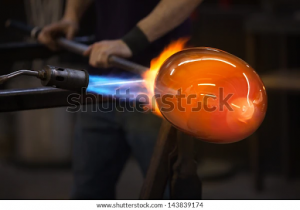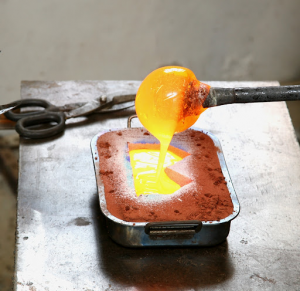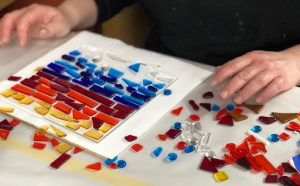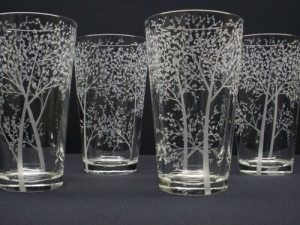
Glass is an amazingly versatile art material that can be formed and shaped in many different ways. It has the artistic quality of being able to bend and reflect light in a very unique manner. Its versatility has thus resulted in different types of glass art techniques.
There are primarily three categories of glass art techniques. Artists use them according to their needs and the purpose of glass art. These handmade glass art techniques are:
- Hot Glass Technique
- Warm Glass Technique
- Cold Glass Technique
There are various methods used to create glass art within these methods. In this guide, we’ll explain each glass art technique in detail.
1. Hot Glass
Hot glass is a technique that includes working with molten glass at high temperatures using glass casting molds. Here is how it works:
- Place pieces of glass in a furnace
- Heat the furnace to approximately 2000oF
- The process makes the glass malleable
- Collect the molten glass from the furnace
- Use this hot viscous glass in glass sculpting, blowing, and casting into molds
Hot glass is used to create various glass art items such as:
- Bowls
- Vases
- Sculptures
- Goblets
- Containers
- Ornaments
and more.
Types of Hot Glass Techniques
Hot Glass Blowing
It is the art of creating glass sculptures by shaping hot molten glass. Here is how you do it:
- Collect the molten glass by inserting the tip of a blowpipe into the furnace
- Roll the pipe until a gob of glass attaches to it
- Roll the gob on a flat metal slab
- Create a sort of bubble of glass by blowing from the other end of the pipe
- Constantly blow and roll the pipe to get the desired shape
- Remove the glass from the glass pipe with the help of steel tweezers
Hot Glass Casting
It is a process of casting glass art by placing hot molten glass into a casting mold. The temperature of the glass is slowly brought down to room temperature. There are 3 types of hot glass casting. Here we explain how to cast hot glass.
Sand Casting

- Carve the required design into the treated sand to form a mold
- Pour the hot molten glass into the sand mold
- Wait for the glass to cool down
- Once the glass is solidified, remove the sand
- Reveal a perfect solidified casting
Ideal for creating multiple glass art with rough-textured granular surfaces.
Open-Faced Molding
- Make a clay mold
- Pour plaster around a clay pattern
- Let it set
- Remove the clay
- Dry the plaster mold in the oven
- Fill the mold with glass
- Cast it in a glass kiln
Ideal for casting glass art where one side is flat—coasters, glass tile, etc.
Lost Wax Casting
- Build a mold around sacrificial wax
- Melt out the wax to form a cavity
- Pour molten glass into the cavity
- Let it cool
- Remove the mold
- Get the final glass piece
Ideal for creating highly detailed glass art.
2. Warm Glass
Warm glass is a technique to create glass art at a temperature of 1200-1600oF. Instead of the glass furnace, the warm glass technique usually involves a kiln/oven. Common terms often used for warm glass are:
- Kiln-Cast Glass
- Kiln Glass
- Fused Glass
- Slumped Glass
- Glass Bending
- Bent Glass
and more.
Warm glass is used to create various glass art items such as:
- Sheets
- Tiles
- Plates
and more.
Types of Warm Glass Techniques
Slumping
It is a technique of heating flat sheet/plate glass to give it the desired shape of the surface below. Here is how you do it:
- Design a mold
- Lay a glass sheet or plate over the mold
- Put it in a kiln
- Fire it up to 1300 degrees Fahrenheit
- The glass melts down due to the heat
- The gravity pulls the glass down into the mold
- Wait for the glass to cool down
- Remove the mold
- Get final glass art piece
Ideal for creating larger, functional glass pieces—bowls, dishes, plates, ashtrays, etc.
Fusing

It is a process of heating two or more pre-cut pieces of glass to melt together. It allows you to create dynamic, colorful pieces of unique glass art. Here is how it’s done:
- Prepare your kiln
- Cut the glass into desired shapes
- Make sure the glass is clean
- Assemble the glass into the kiln
- Fire the kiln to a suitable temperature
- Check to see that the glass is completely cool
- Remove your glass piece, and it’s done
Stand back and admire your fused glass.
Ideal for creating glass tiles, notably beads, jewelry, etc.
3. Cold Glass
The cold glass category includes all kinds of glass art techniques that don’t involve high temperatures. It helps cold glass artists to work on glass art without heating the glass. This type of glass working is usually performed in combination with hot and warm glass.
Types of Cold Glass Techniques
Etching
It involves applying a strong acid such as hydrofluoric acid, to the surface of the glass. It helps you change the texture & appearance of the glass. Ideal for getting a translucent matte finish.
Engraving

It is a process of inscribing onto the glass surface. There are 3 types of engraving methods:
- Tool Engraving
- Rotary Engraving
- Laser Engraving
Sandblasting
Involves blasting with gritty material against the surface of the glass. Sandblasting offers the same effect as acid etching. Some of the most common grit materials are:
- Aluminum Oxide
- Silica Carbide
- Quartz Sand
- Steel Grit
- Soda
- Glass Bead
Important Note: Use dichroic powder to fill sandblasted patterns.
Grinding
Grinding helps you achieve a certain shape. You can grind excess glass on your glass pieces with the help of grinding tools such as:
- Abrasive Stone Burrs
- Diamond Hand Pads
- Diamond Files
- Diamond Burrs
et cetera.
Polishing
Glass polishing eliminates defects—scratches, pitting, etc.—that have formed on the glass. It helps you restore the original brightness and transparency of the glass. Some of the most common polishing tools are:
- Microfiber Dishcloth
- Electric Polisher
- Velcro Discs (ranging from 150 to 1000 grains)
*Important Note: Before using any technique (especially hot & warm), make sure to follow all the safety procedures. It is highly risky to work with such high temperatures. Without the proper knowledge, do not operate glass machines/tools—glass kiln, grinding tools, engraving tools, etc.
Conclusion
With so many choices available for glass art, you can choose the one that meets your needs. Now you know what hot, cold, & warm glass techniques are. We hope this guide will help you to better understand glass art techniques.
